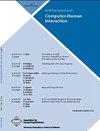Gazing Heads: Investigating Gaze Perception in Video-Mediated Communication
IF 4.8
2区 计算机科学
Q1 COMPUTER SCIENCE, CYBERNETICS
引用次数: 0
Abstract
Videoconferencing has become a ubiquitous medium for collaborative work. It does suffer however from various drawbacks such as zoom fatigue. This paper addresses the quality of user experience by exploring an enhanced system concept with the capability of conveying gaze and attention. Gazing Heads is a round-table virtual meeting concept that uses only a single screen per participant. It enables direct eye contact, and signals gaze via controlled head rotation. The technology to realise this novel concept is not quite mature though, so we built a camera-based simulation for four simultaneous videoconference users. We conducted a user study comparing Gazing Heads with a conventional “Tiled View” video conferencing system, for 20 groups of 4 people, on each of two tasks. The study found that head rotation clearly conveys gaze and strongly enhances the perception of attention. Measurements of turn-taking behaviour did not differ decisively between the two systems (though there were significant differences between the two tasks). A novel insight in comparison to prior studies is that there was a significant increase in mutual eye contact with Gazing Heads, and that users clearly felt more engaged, encouraged to participate and more socially present. Overall, participants expressed a clear preference for Gazing Heads. These results suggest that fully implementing the Gazing Heads concept, using modern computer vision technology as it matures, could significantly enhance the experience of videoconferencing.凝视头部:调查视频传播中的凝视感知
视频会议已成为无处不在的协同工作媒介。然而,它也存在各种缺点,如缩放疲劳。本文通过探索一种能够传达注视和注意力的增强型系统概念,来解决用户体验质量问题。Gazing Heads 是一种圆桌虚拟会议概念,每个与会者只使用一个屏幕。它可以实现直接的目光接触,并通过受控的头部旋转发出注视信号。不过,实现这一新颖概念的技术还不太成熟,因此我们为四个同时参加视频会议的用户建立了一个基于摄像头的模拟。我们进行了一项用户研究,比较了 "凝视头 "和传统的 "平铺视图 "视频会议系统,每组 4 人,每组 20 人,分别完成两项任务。研究发现,头部旋转能清晰地传达注视信息,并能强烈地增强对注意力的感知。对轮流行为的测量在两种系统之间没有决定性的差异(尽管在两项任务之间存在显著差异)。与之前的研究相比,一个新的发现是,与 "凝视头 "的相互目光接触显著增加,用户明显感觉到更投入、更受鼓励参与和更有社会性。总体而言,参与者明显更喜欢 "凝视头"。这些结果表明,随着现代计算机视觉技术的成熟,全面推行 "凝视头 "概念可以显著提升视频会议的体验。
本文章由计算机程序翻译,如有差异,请以英文原文为准。
求助全文
约1分钟内获得全文
求助全文
来源期刊

ACM Transactions on Computer-Human Interaction
工程技术-计算机:控制论
CiteScore
8.50
自引率
5.40%
发文量
94
审稿时长
>12 weeks
期刊介绍:
This ACM Transaction seeks to be the premier archival journal in the multidisciplinary field of human-computer interaction. Since its first issue in March 1994, it has presented work of the highest scientific quality that contributes to the practice in the present and future. The primary emphasis is on results of broad application, but the journal considers original work focused on specific domains, on special requirements, on ethical issues -- the full range of design, development, and use of interactive systems.
 求助内容:
求助内容: 应助结果提醒方式:
应助结果提醒方式:


